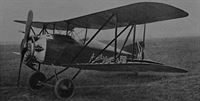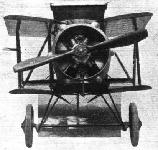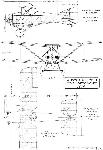A.Jackson British Civil Aircraft since 1919 vol.1 (Putnam)
AUSTIN WHIPPET
Single-seat light plane powered by one 45-h.p. Anzani, built 1919 by the Austin Motor Co. Ltd. Three aircraft only: K-158/G-EAGS, c/n AU.1, C. of A. issued 4.12.19; G-EAPF, c/n AU.2, C. of A. issued 7.10.24, last of six owners H. M. Pearson, Hamble, 4.29, sold in New Zealand 1931 as ZK-ACR; G-EAUZ, c/n AU.3, taken to the Argentine by A. J. Greenshields 1920 and flew till 1928. Span, 21 ft. 6 in. Length, 16 ft. 3 in. Tare wt., 500 lb. A.U.W., 730 lb. Max. speed, 85 m.p.h.
Показать полностью
Журнал Flight
Flight, August 14, 1919.
THE AUSTIN "WHIPPET"
UP to now it has been necessary for the "Amateur" pilot to have a certain amount of mechanical knowledge, in addition to knowing how to fly, in order to keep his machine in flying trim and safe - unless, of course, he has the services of a skilled mechanic or mechanics. In other words, the non-mechanical owner-pilot has only now been catered for in the Austin "Whippet," which has just been produced by the Austin Motor Co., Ltd., of Birmingham, to the designs of Mr. J. Kenworthy - the firm's chief aeronautical engineer, associated in the early days with Mr. G. de Havilland at the Royal Aircraft Factory.
The salient points of the Austin "Whippet" are :- It is a small single-seater tractor biplane with an all-steel fuselage, folding wings, no bracing wires, and it is a safe and easy machine to fly. Furthermore, it is proposed to place this machine on the market at the comparatively low price of ?400 to ?500.
In view of the fact that bracing wires have been practically eliminated, and that the wings are made to fold back, the "Whippet" is a machine that should appeal particularly to the "owner-pilot," for frequent adjustments and rigging - especially when folding the wings in position for flight - are thus avoided, whilst the machine can be housed in quite a small building or tent, one 8 ft. wide, 18 ft. long, and 8 ft. high being sufficient for the purpose.
As shown in the accompanying scale drawings, it is fitted with a two-cylindered horizontally-opposed engine, but we understand that a six-cylindered 45 h.p. Anzani engine will be fitted in all future models.
The principal dimensions of the "Whippet" are: Span, 21 ft. 6 ins.; length, 16 ft.; chord, 3 ft. 8 ins.; area of main plane, 134 sq. ft. The weight of the machine empty is 500 lbs., and fully loaded 730 lbs. It has a speed range of 30 to 95 m.p.h., and climbs to 5,000 ft. in 6 mins., and 10,000 ft. in 14 mins. Fuel is carried for a flight of two hours' duration.
As previously stated, the fuselage is of steel construction throughout, and is built up in two sections, being divided at a point immediately behind the cockpit. The longitudinals, diagonals and cross-members are of circular-section steel tubing, and are readily replaceable. Bracing wires are entirely eliminated, and it is claimed that the whole frame-work is not affected by climatic conditions. The engine is overhung from the front of the frame, and a special shock-absorbing device, consisting of rubber buffers, is fitted between the fuselage and the engine-bearer. The engine is enclosed in an aluminium cowling.
The main planes have been designed with a high factor of safety, and are of standard wood construction with hollow box-section spars. Steel tubes are employed for the compression members, and internal bracing is by steel piano-wire. One set of "N" struts, of streamlined steel tubes, separate the top and bottom planes on each side of the fuselage, and the top centre section is supported above the fuselage by two pairs of vertical streamlined steel struts. This portion of the cellule alone is wire-braced. The upper and lower wings are hinged at the roots of the rear spars to the top centre section and fuselage respectively. Bracing for lift and incidence is by streamlined steel tubes, which are anchored at their lower ends to the roots of the lower wings, and are thus not disconnected when folding the wings. In order to correct incidence, the rear lift struts are made adjustable. Both upper and lower wings are given a dihedral of about 5°, but are otherwise "straight." The top plane is staggered forward some 3 ins. When folded back the wings are supported and locked by tubes attached to the fuselage, and when in flying position are locked by a quick-release but positive locking device. Ailerons are fitted to the top planes only.
The tail plane is of similar construction to the main planes, and consists of two outer portions and a centre portion, which simplifies the question of spares, as either outer portion can easily be changed. The tail plane is of comparatively thick streamline section, and is braced by telescopic streamlined steel tubes. Its angle of incidence can also be adjusted to correct the e.g. for different weights of pilots. The elevators and rudder are of standard design, the framework being of steel tubing and the ribs of wood. A triangular vertical fin is mounted both above and below the fuselage.
The landing chassis is of the ordinary V-type, the V-struts terminating at their lower ends in pressed steel sockets, tubular tie-rods connecting each V. The axle rests in between the V where it is attached by the usual elastic cord. Bracing is by streamline steel wire. The tail skid is of the swivelling type, the skid itself being made of two steel pressings welded together. In order to provide a good wearing surface, a special shoe is fitted, consisting of ten vertical laminated plates. The springing of the skid is obtained by making the supporting strut of telescoping tubes operating on a compression spring.
The elevators and ailerons are operated in the usual way by a "joy-stick," and the rudder and tail skid by rudder-bar. Operating rods are used for the engine control. For starting the engine a small induction pump is fitted, which forces a firing mixture into the cylinders, and a starting magneto inside the fuselage ignites this charge.
Показать полностью







